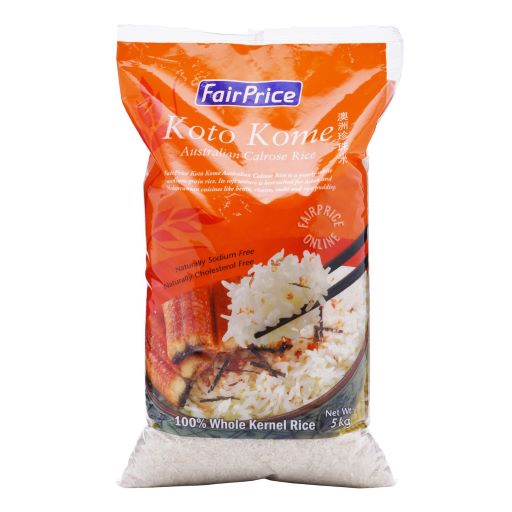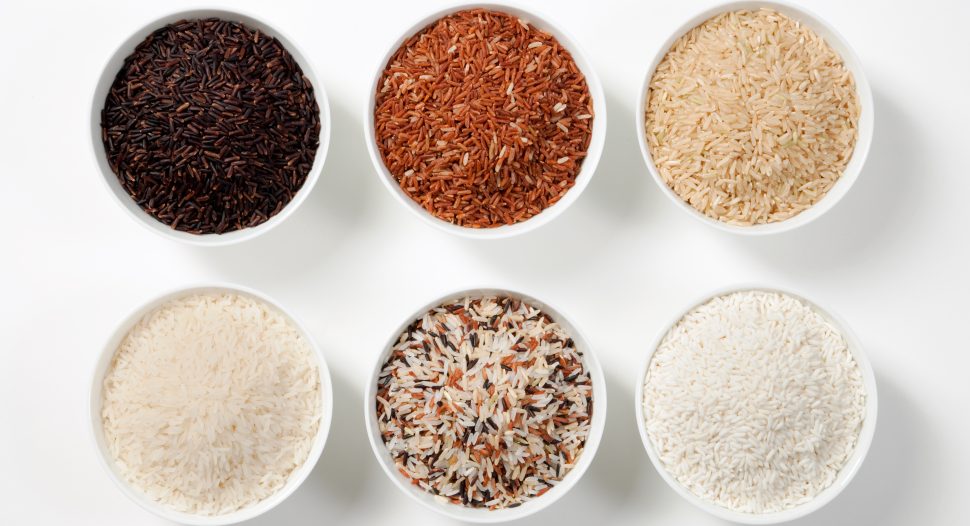Rice is rice, right? Not really!
While there are nearly 40,000 varieties of rice available¹, not all are created equal! The rice you choose to cook can make or break your meal.
All you need to keep in mind is grain length. Grain length is a good indicator of its texture when cooked and consequently, how it should be prepared. Keep an eye out for these 8 types of rice you need to know and how to cook them!
Long-grain rice
True to its name, long-grain varieties like basmati and jasmine rice are slim and lengthy — nearly four to five times longer than it is wide². They also have the lowest starch content of the varieties on this list. This means firm and fluffy grains that stay separate after cooking! Jasmine rice has a uniquely sweet scent and smooth silky texture.
FairPrice Thai Hom Mali Superior Fragrant Rice proudly bears a Quality Certification Mark endorsed by the Royal Thai Government. This means you’re getting a pack of genuine fine rice quality!

But don’t take our word for it, take our customers’ word for it:
“Rice is very fragrant and texture is just right! It is comparable to a popular brand BUT at a much affordable price! I tried comparing and couldn’t tell them apart! Highly recommend!”
(@WENYA.LEE, 33 years old)
“Pleasantly surprised with the quality of the rice at a pocket-friendly price! It’s fragrant and fluffy to consume on its own. The texture is great too even when I get creative and cook it with some Rolled Oats!” (@XINDERELLA, 36 years old)
Separately, if you’re looking for healthier options, go with Thai brown or red rice instead. Their natural hue retains all the important vitamins and minerals without further processing to make it a more wholesome wholegrain staple for the entire family!
If you’ve got a fussy eater who isn’t used to seeing brown or red rice on their plate, ease into it with this wholesome mixture with fragrant white rice!
Medium-grain
Shorter to medium-grain varieties like arborio and calrose rice are usually about two to three times longer than they are wide³. When cooked, this variety produces moist and tender, yet slightly chewy grains that stick to each other when cooked.

This pearly white FairPrice Kote Kome Australian Calrose Rice is the perfect option to start with. It’s suitable for Asian cooking, even in local delights with a twist like this Masterchef-endorsed Xi’an Spiced Chicken with Fragrant Rice!
Did you know? The name “cal” is a nod to California in the United States of America (USA) where the grain originated from. “Rose” is the continuation of a naming tradition that includes “Blue Rose”, another medium-grain variety previously developed in Louisiana, Texas⁴!
Short-grain
What’s shorter and stickier? Short-grain rice! With most varieties measuring in at just under 5.5 millimetres⁵, short-grain rice has both savoury and sweet applications. The high levels of starch is what gives the super creamy texture in rice-based recipes like risotto.
For example, the pearly-white silken grain of japonica rice is ideal for lining nori sheets with meat and vegetables to make sushi.

FairPrice Premium Japonica Rice
Short Grain
2.5kg
If you’ve got a sweeter tooth, you’d be glad to know that the unique consistency of glutinous rice is what distinguishes it as sticky rice. Sticky rice (Oryaza sativa glutinosa) is also high in sugars such as dextrin and maltose; when cooked, the grains tend to “stick” together in a single mass⁶.
It’s used in dishes and desserts across Asia from Thai mango sticky rice to Japanese mochi and delectable dim sum in Hong Kong!

FairPrice Thailand Rice
Glutinous
2.5kg
Did you know? Glutinous rice is actually gluten-free! It’s called glutinous due to its sticky “glue-like” texture.
Parboiled
Lastly, ponni rice is the new short-grain variety to know! Ponni rice is widely harvested and uniquely processed in India. The just-harvested rice is soaked, steamed and dried with the hull still on each grain. The grain is left to absorb the nutrients into the hull and brain to give it a firmer texture overall.
Once this is completed, then the hull is removed. This gives parboiled ponni rice a pretty light yellow colour!

FairPrice India Ponni Rice
Parboiled
5kg
Unlike short-grain japonica and glutinous rice, parboiled ponni rice has an extra fluffy and firm texture with separated grains. The grains stand up well in a soup or stew and turn creamy white once cooked! They’re also perfect in pilafs and salads.
We hope that you’ve learnt all about the different types of rice and how to cook them properly. Be adventurous and pick up a different sack of rice to try in your next meal!
***
References:
¹ Lee, D 2020, The different types of rice you need to know and cook, Fine Dining Lovers, viewed 14 September 2021
² Foster, K 2016, What’s the difference between short-, medium- and long-grain rice?, Kitchn, viewed 14 September 2021
³ Sebazco, E 2017, Long, medium and short, Live Rice, viewed 14 September 2021
⁴ Sugg, K 2021, What is calrose rice?, Allrecipes, viewed 14 September 2021
⁵ Vaughan, K 2020, What’s the difference between long- and short-grain rice?, Martha Stewart, viewed 15 September 2021
⁶ Masterclass 2020, Guide to sticky rice: how to make glutinous rice, viewed 15 September 2021







